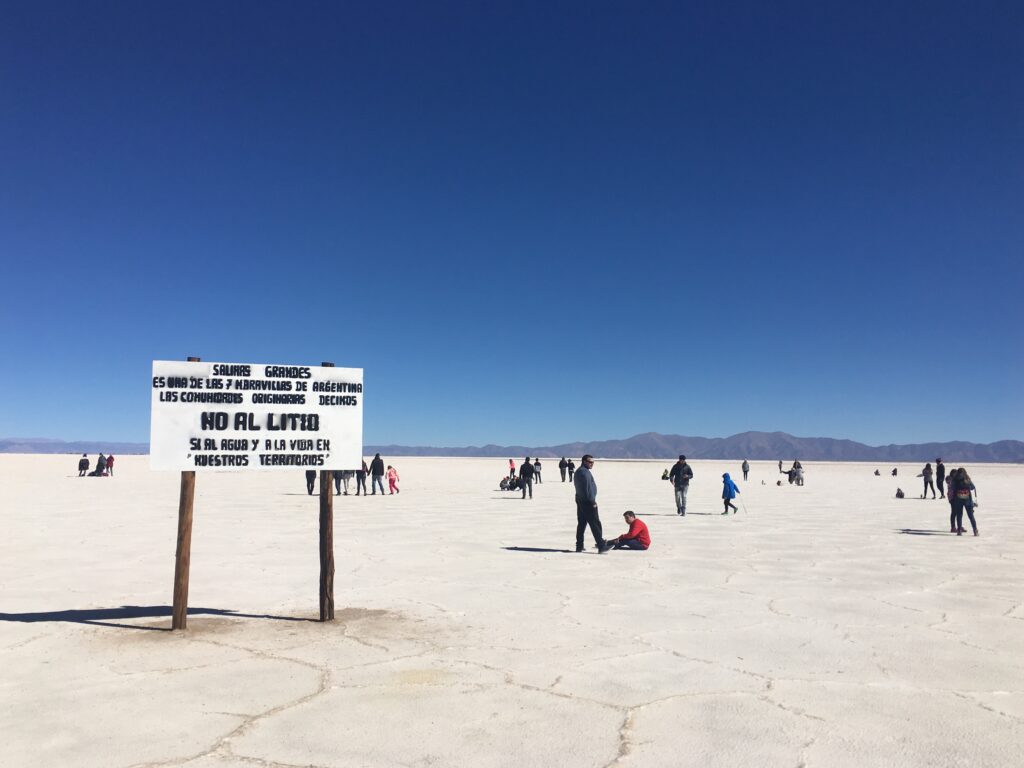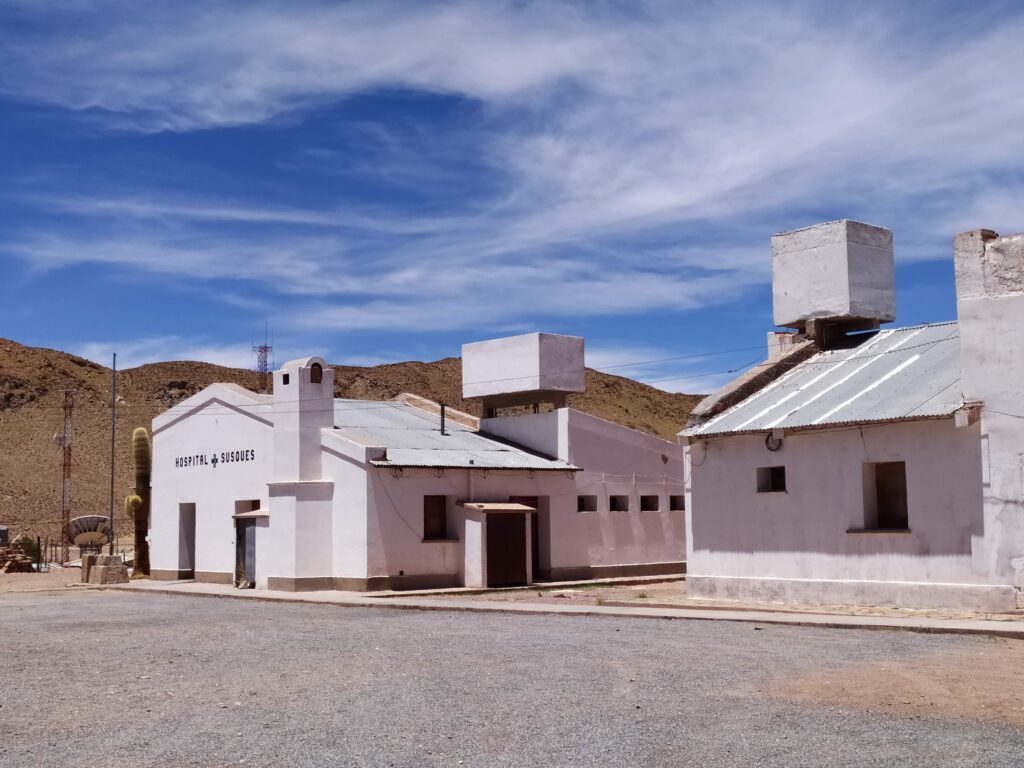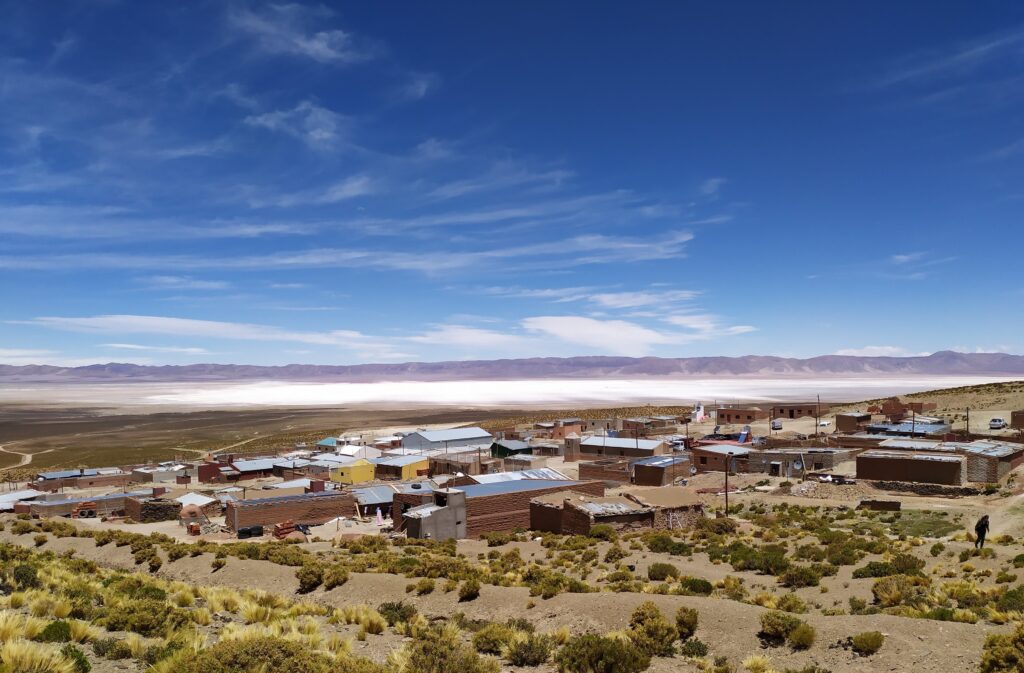Salinas Grandes
Salinas Grandes appears suddenly, like a mountain top, suddenly rising up after a curve. It is not even 9 am yet, but like every December morning, at 3,450 meters above sea level, sun and wind make their presence felt. Like a sea of salt, the Salinas Grandes and Laguna de Guayatayoc basins stretch out over the provinces of Salta and Jujuy. More than 30 indigenous communities, that belong to the Kolla ethnic group, live around the salt flat. The 52nd National Highway crosses the salt flat and continues towards Olaroz Chico. Halfway through, there is a tourist stop. Some communities have grouped together and created a tourist venture through which they show newcomers the “eyes of the salt flat” (holes in the salt layer allowing you a glimpse of the inside of the salt lake), and a salt cooperative called Mineros de Salinas Grandes. They show us how they live – for generations, the communities of Salinas Grandes have worked with salt.
We met with three women in charge of the tours to the salt flat. They organize themselves in rotating shifts so that the income generated by tourism is shared equally amongst them. Looking to the salt flats we see a handmade sign that announces what they are about to talk to us about: “we kicked out the lithium firms”.

As a result of conflicts with extractive projects, in 2010 the 33 Communities of Salinas Grandes y Laguna de Guayatayoc organized a roundtable, followed by mobilizations and roadblocks to protest against illegal mining activities. The communities remain in a state of permanent assembly demanding the area to be declared as “a natural, cultural and ancestral heritage of the native peoples, a zone free of mega-mining, lithium mining, and any other extractive project that harms the Pachamama (Mother Earth in the Aymara and Quechua languages) and threatens the communities’ ancestral way of living”.
A few meters from the community reception center, Manuel (fictitious name) has a stall where he sells handicrafts made of salt. He is a member of the community Santuario Tres Pozos. We cannot see his face because it is completely covered, with dark sunglasses and protective clothing. Because here, in one of the driest regions on earth, the wind and salt burn your skin and blind your eyes. But it is this same region they love and respect. He tells us how, since 2011, they have been organizing themselves. Every month they have a “Mesa Chica” in Jujuy, a small roundtable where representatives of all the communities meet up to discuss territorial issues specifically related to lithium. It is breathtaking to listen him explain, slowly and patiently, the reasons for their resistance to lithium mining. His concern is water; his greatest fear is how mining will affect the environment. People from Susques, living near projects that are already in a production stage, say that they have stopped keeping animals precisely because there is less water and the animals would die.
Susques
After crossing the “Salar Grande” (Big Salt Flat, as the locals call Salinas Grandes) we continue on our way to Susques, a town of almost 1700 inhabitants. It is located at 3,675 meters above sea level, where the Pastos Chicos and Susques rivers meet. The communal territory of the Indigenous Community Pórtico de los Andes, which belongs to the Atacameño ethnic group, is located nearby. Since 2007, the community possesses the land rights under a communal ownership.
We arrived around noon and the town was bustling: people coming in and out of the town hall, municipal works in full swing, and the large power generator running with a constant deafening hum as a soundtrack to the streets of this town. “If you’re looking for people to hire, you won’t find them here,” one of the community representatives told us, referring to the fact that most of the people in Susques already have jobs. Traditionally, local families have lived off pastoralism, as is common in many parts of the high Andes. Camelid herding is complemented by small crops and seasonal jobs. Although these activities have not completely stopped, many of the community’s inhabitants are currently employed in the mining industry.

Orlando is nearing the end of his term as municipal commissioner of Susques. He welcomes us kindly and smiles, happy to spend some time with us. He explains what mining means for this town and the families of Susques. What we hear stands in contrast with the situation in Salinas Grandes: he emphasises the creation of jobs and the opportunity of professional training for young people. But he is also worried about water consumption and the impacts that might be seen only 10 to 15 years from now. In Jujuy, the mining firms carry out a “consultation” process through informative and consultative meetings. In these encounters, the communities must express or withhold their consent in regard to a particular project. Orlando, who knows the conflicts and ambivalences surrounding mining very well, tells us that during his mandate the Municipal Commission only authorized projects that had the consent of all communities in the area. By the end of our conversation, informed by local wisdom, Orlando raises crucial geopolitical issues: “God willing, someday an electric car will arrive here. I believe that we are benefiting other people, other continents, other parts of the world that are overwhelmed and plagued with pollution. We are in a pure place, and they are coming in to take from the natural abundance here.”
Olaroz Chico
The next day, we arrived at Olaroz Chico, an Atacama community of about 250 inhabitants, located at the foot of the Olaroz salt flat at 4,500 meters above sea level. The community also possesses the legal rights to its land and, according to what we were told in Susques, the community was the first to give their permission to a lithium mining firm. We meet with Juan, the community representative, at the communal office. He gets out of a truck and explains that the vehicle is owned by the community and that it is used for whatever is needed. He addresses crucial issues in a serious, but not shy, manner. Almost without being asked, he tells us that the process of accepting the lithium mining companies was not easy, as some of the communities were against the projects. Olaroz Chico met with Sales de Jujuy (currently producing lithium), the governor of Jujuy, and even with President Cristina Fernández de Kirchner, to demand the approval of the project. At this point in the conversation we are interested in fully understanding why the arrival of these companies was so important for Olaroz Chico.

But for Juan this is quite obvious. He told us that Olaroz had always been a mining town, that they used to work in borate extraction but that this involved “a lot of suffering”. The working conditions were terrible and they were rarely even paid with money; they usually received vouchers to exchange for foodstuffs. For this reason, many local people emigrated. For Juan, lithium mining provides a way for local people to stay in their birthplace. So what would be the drawback? Currently, Olaroz Chico receives royalties from Sales de Jujuy, which operates almost solely within the community’s territory. The firm has also contributed to the construction of a technical college in the town, provides occasional training, and has funded community members to provide them with different basic services including catering, laundry, construction, passenger transportation, and accommodation.
What the price to be paid for the economic improvements that lithium has brought for some of the communities still remains to be seen. What is clear is the fact that traveling the Puna is an invitation to slow down, to take a stroll in a lost paradise, to visualize the symphony of colors and to listen to the stunning silence. The people with whom we talked during our journey have different opinions about lithium spanning very diverse elements, and personal trajectories. If there is something that runs through each of the stories, it is the will of those who narrate them to continue living in the place where they were born, the cultural identity and the feeling of belonging. This is present in each of the cultural expressions we witnessed, but also in the silent streets of the communities and within the way that takes us back home, passing by colossal lava cliffs, and vast valleys.
About the authors
Araceli Clavijo has a PhD in Science and is a postdoctoral researcher at the National Research Council of Argentina (CONICET). She works on sustainable water and sanitation management; and water governance within the Water and Energy Nexus approach.
Melisa Escosteguy is PhD student in Anthropology and scholarship holder with the National Council of Scientific and Technical Research of Argentina (CONICET). She is doing research on political ecology of lithium and just energy transitions.
Congratulations for your article. It is a huge contribution from society. The way that the stories was narrated makes me travel to the place. I live in Brazil and working with fishing communities about potential impacts of offshore wind farms. Thanks!